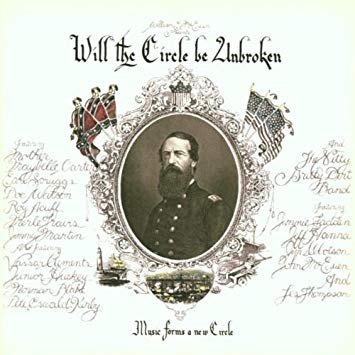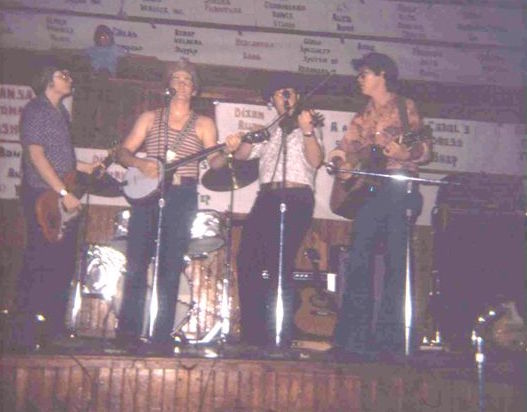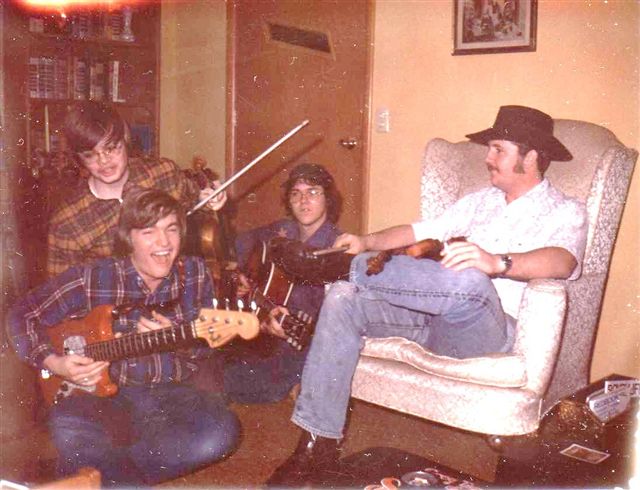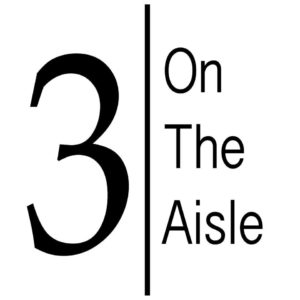Various forms of the records-that-changed-my-life meme have been making the rounds lately, so I came up with my own version, which I call “The Twenty-Five Record Albums That Changed My Life.” I’m writing about one of these albums each weekday in the rough order in which I first heard them.
22. The Nitty Gritty Dirt Band, Will the Circle Be Unbroken (United Artists)
I took no note of Will the Circle Be Unbroken when it came out because I didn’t listen to country music. The kind of country that you heard on the radio in 1972 in Smalltown, U.S.A., was mostly the kind for which I had no use whatsoever and still don’t, the insipid “Nashville Sound” 101-Strings ballads that even now can send me running from the room with hands clamped on ears unless they’re sung by the ennobling likes of George Jones.

It was Greg Tanner who changed my mind about the other kind of country music. He was a couple of years older than me, and we met when I entered high school and started playing in the school orchestra. He was a chunky, funny guy with the thickest hick accent I’d ever heard, which he used to conceal the fact that he was both intelligent and sensitive, something he didn’t care for anybody to know. He was also a pretty decent violinist and a very good fiddler who used to play bluegrass and country music for fun during our rehearsal breaks. I was fascinated by the unfamiliar tunes that he tossed off, and in due course we became friends and teamed up with two of his other friends, Ken Harbin and Chuck Hanna, to start a four-piece country-and-bluegrass band that we called Sour Mash.
Greg, Ken, Chuck, and I spent the next couple of years gigging around Smalltown and its environs. Chuck had his own circle of intimates and mostly kept to himself, but Greg, Ken and I were soon spending most of our weekends hanging out together, something I’d never done with male friends of my own age. I wrote about those weekends many years later in a memoir of my small-town childhood and youth:The three of us did more than just play music and go cruising. We ate meals together. We went camping together. We spent time with each other’s families. We drove out to a deserted bean field one hot summer afternoon and shot bottle rockets at each other. Losing an eye or a finger would have been a stiff price to pay for a good time, but I probably would have paid it without complaining, for I knew the value of my friendship with Greg and Ken. They did their best to teach me how to be a regular guy, taking me by the hand and leading me through the nighttime world of truck stops and chicken-fried steak. I could do little for them in return except play bass and serve as a full-time butt for their practical jokes, but that seemed to be enough. I spent hours watching them shoot pool and drink beer in a seedy dump on Highway 61. One night I overheard Greg talking about me to a fellow at the bar who was wondering why I tagged along. “Hell, yes, he’s strange,” Greg said, “but who gives a shit? He can play the goddamn bass, can’t he? What do you want? A quarterback?”

The friendship was more important to me than the music we made, but the music mattered, too, far more than I understood at first. I learned how to play it from Will the Circle Be Unbroken, which contains such down-home standards as “I Saw the Light,” “Lonesome Fiddle Blues,” “Lost Highway,” “Nine-Pound Hammer,” “Orange Blossom Special,” and “Wreck on the Highway,” all of which insinuated their way into my smartest-boy-in-town blood and became part of my musical DNA. Before long I’d fallen in love with the rootsy, life-is-like-this simplicity of old-time, stone-hard country music. I love it as much now as I did back then—probably even more, since I’ve lived long enough to have felt the soul-wracking hurt that it so often portrays so honestly and well.
In time the four of us graduated from high school, went off to make our separate ways in the world, and mostly lost track of one another save for increasingly infrequent yet always heartfelt reunions. Greg and Chuck are dead now, but Ken, who lives in Kentucky, still stays in touch with me via e-mail, and once in a while we share our unfaded memories of the days when we played music and pinball together and learned how much it means to be a friend.
(To be continued)
* * *
“Avalanche,” from the original Will the Circle Be Unbroken album, played by Vassar Clements and the Nitty Gritty Dirt Band:
“Tennessee Stud,” from the original Will the Circle Be Unbroken album, played by Doc Watson and the Nitty Gritty Dirt Band:
“Will the Circle Be Unbroken,” performed live in 1990 on Austin City Limits by the Nitty Gritty Dirt Band and a group of guest artists, including Del McCoury:
* * *
To read about album #1, go here.
To read about album #2, go here.
To read about album #3, go here.
To read about album #4, go here.
To read about album #5, go here.
To read about album #6, go here.
To read about album #7, go here.
To read about album #8, go here.
To read about album #9, go here.
To read about album #10, go here.
To read about album #11, go here.
To read about album #12, go here.
To read about album #13, go here.
To read about album #14, go here.
To read about album #15, go here.
To read about album #16, go here.
To read about album #17, go here.
To read about album #18, go here.
To read about album #19, go here.
To read about album #20, go here.
.To read about album #21, go here.

